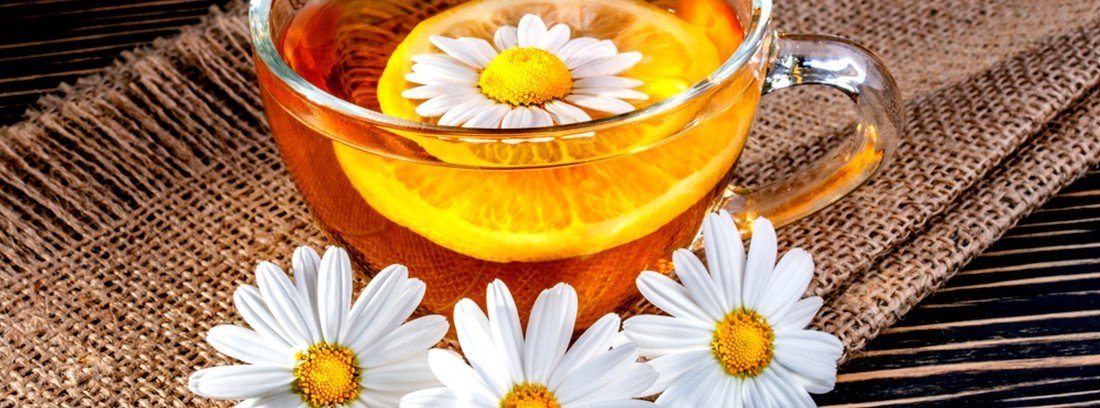Chamomile, digestive balm

Various medicinal plants of the Asteraceae (compound) family are known under the common name of "chamomile". In Spain, depending on the geographical area, different plants of the same family are called chamomile, although as a general rule the term is used to name the plant that is known by the botanical name of Matricaria recutita L, or by its synonyms Chamomilla recutita (L) Rauschert or Matricaria chamomilla L.
It is a herbaceous, annual, aromatic plant, with a branched, cylindrical, striated and downy stem up to 60 cm high, and that has a whitish green color. The leaves are alternate, 5 to 7 cm long, finely divided (2 to 3 times). Its flowers are yellow and tubular, and gather, at the end of the peduncle, in solitary chapters, surrounded by white bracts (ligules) that look like petals. The fruit is an achene. The dried flower heads are used from this plant. Although it is native to Europe and Asia, today it can be found almost all over the world. It grows easily in drained and sunny soils, although it is a resistant plant capable of surviving frost and adverse conditions such as a lack of nutrients or the acidity of the soil.
Medicinal uses of chamomile
The name chamomile derives from the Greek term, which means "dwarf apple." The term has its origin in the word "matrix" and refers to its use in disorders female menstruals. The infusion of this plant is also popularly known as chamomile.
The use of chamomile dates back to very ancient times. There is evidence of its use in the old Egypt, Greece and Rome. The ancient Egyptians used it for medicinal purposes and as an offering to Ra, the Sun god, and it is believed that in these small flowers they saw a symbol of the astro-god. Chamomile has been known and appreciated for thousands of years and traditionally used as disinfectant, tranquilizer, against menstrual pain and for It was also used by the Celts and is part of the 9 sacred herbs.
In the Middle Ages, it was used to bitter beer before hops began to be used. In France until recent times it has been used in certain regions in medicinal wines: the flower heads are macerated in wine, which is drunk as an aperitif to whet the appetite.
Currently, it is a highly studied plant and the World Health Organization (WHO) monograph recommends it internally for the symptomatic treatment of digestive disorders, mainly thanks to its essential oil and. Chamomile is often used for poor digestion, mild gastrointestinal spasms, bloating, flatulence, or nausea. They are also recommended, in external application, against inflammations and skin and mucosal irritations, and in rinses for minor conditions of the mouth, gums or pharynx.
How to take it?
Generally, digestive balsam chamomile is taken in herbal tea, although there are also preparations in drops based on fluid extract.
- Adults: two or three infusions a day after meals. The infusion is prepared with a dessert spoonful of floral chapters (or a pre-dosed bag) per cup of water. The fluid extract at a rate of 1 to 4 ml, three times a day, dissolved in a little water.
- Children over three years of age: infusion of a teaspoon of flower head coffee two to three times a day.
For children under three years it is convenient to use products formulated exclusively for them. They are usually presented in the form of instant herbal teas and generally in combination with other plants that complement their action.
How to prepare a herbal tea?
According to the monograph of the European Commission, the infusion should be prepared by pouring approximately 150 ml of boiling water over a heaping teaspoon of flower heads (approximately 3 g). Cover it and let it rest, after 5-10 minutes, filter it and drink it.
Unwanted effects and recommendations
Common chamomile has a much lower allergenic potential than other chamomiles, although allergic reactions have been reported in some cases. nausea and vomiting have occasionally occurred. These, however, were due to the poor quality of the product that, together with the flower heads, contained pieces of stems and leaves whose high content of bitter substances can cause nausea and vomiting in some people.
It is confused with other plants
In Spain, as has been pointed out, depending on the region it is known under the chamomile name to different plants, which can lead to confusion. Thus, to cite a few examples:
- Also known as chamomile is Chamaemelum nobile or Anthemis nobilis, which grows in different regions and is commonly known as chamomile or Roman chamomile. It is more bitter than common chamomile and with a double row of white ligules.
- Matricaria aurea grows in the Belalcázar area (Córdoba province), which is known as manzanilla fina or manzanilla verde. Although it resembles common chamomile in terms of aroma and uses, it does not have white ligules.
- Santolina chamaecyparissus or female abrótano is a plant known in Menorca as chamomile or chamomile from Mahón, and in certain towns of Aragon, simply as chamomile.
- The Helicrysum stoechas that grows in the Spanish Levant (Catalonia, Valencia and the Balearic Islands) is also known as Bastard Manzanilla, perpetual de monte or immortelle among other names and does not bear any resemblance to the common chamomile, Santolina chamaecyparisus among others.
INFORMATIVE NOTE
- «The contents included in this section offer information related to existing therapies explained by specialists with experience in the field with an informative objective. MAPFRE does not intend in any case to position itself on its suitability or expressly promote its use »
Maria Jose Alonso Member of medicinal plants and homeopathy of the College of Pharmacists of Barcelona
(Updated at Apr 14 / 2024)